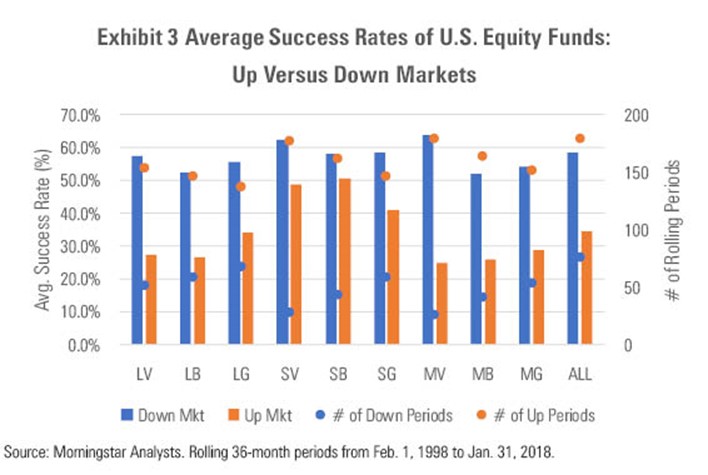The economic calendar is normal but featuring the monthly employment report. Usually that would be the focus, and it might become so by week’s end. Until the situation is clarified, the paramount question will be:
Has the US ignited a trade war?
Last Week Recap
My last full edition of WTWA, two weeks ago, asked whether the coast was clear. Good question, and I guess we got the answer. Last week’s indicator update post pointed to a discussion of an infrastructure bill. In the wake of other events that got no attention at all.
I did cite an escalation of trade rhetoric as among my worries, but it went from worry to major impact much faster than anyone expected. It took only a few minutes!
The Story in One Chart
I always start my personal review of the week by looking at a great chart. The Investing.com version of the S&P futures shows the action while the stock market is closed. The interactive version also lets you specify your choice of both time and intervals. Finally, there is a tag for significant news at various key points.
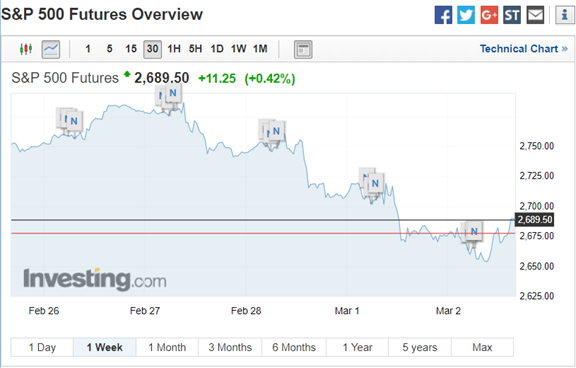
The decline this week included a 5% trading range, continuing the recent record of higher volatility. I summarize actual and implied volatility each week in the Indicator Snapshot.
Personal Note
Spring vacation is coming, even though Spring has not yet arrived. I will be off the week after next, including the weekend before and afterward. I will try to post an indicator update, especially if there are important changes.
The News
Each week I break down events into good and bad. For our purposes, “good” has two components. The news must be market friendly and better than expectations. I avoid using my personal preferences in evaluating news – and you should, too!
The economic news was mixed. Once again, the market reaction had little to do with the news flow.
The Good
- Consumer confidence registered the highest reading since 2000 and the Michigan index is more than 16% above the long-term average. Jill Mislinski has excellent updates on both. Her chart of the Conference Board measure is an example of what you will see in her post.
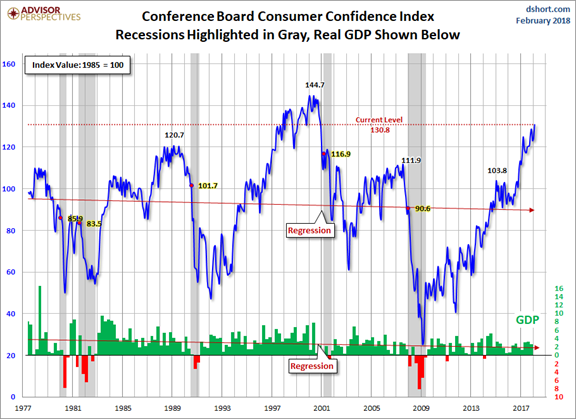
- Personal income increased 0.4%, beating most expectations of 0.3%. Steven Hansen takes his typical deep dive into the report, showing each of the elements as well as historical context.
- Corporate earnings recorded a great quarter and estimates continue to rise. John Butters compares this to the usual estimate declines at this point of the quarter. Brian Gilmartin has repeatedly noted this same trend. The forward earnings skeptics should pay attention!

- Initial jobless claims continue the amazing improvement. Bespoke calls it “ludicrous mode.”
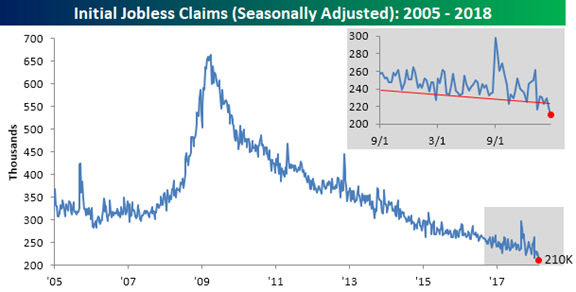
- ISM index shows the strong start to 2018. (Scott Grannis).
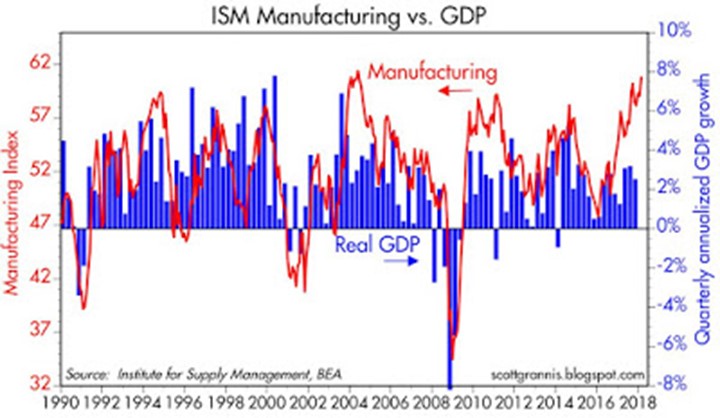
The Bad
- Housing data
- New home sales declined to an annual rate of 593K and a decrease of 1% year over year. Calculated Risk suggests that we be cautious until we have February and March data. This may help determine whether tax law changes are part of the cause.
- Pending home sales declined 4.7% for the month and 3.8% year-over-year. (Calculated Risk).
- Durable goods orders declined 3.7%, worse than the 2.0% expected.
- Auto sales declined 2.4% in February. A combination of reduced incentives (and therefore higher prices), higher interest rates, and tougher credit conditions led to a tough sales market. (WSJ). Bespoke tracks the F150 sales which remained strong. Some treat this as a reflection of small business and construction demand. Perhaps reduced auto sales will not spill into the general economy.
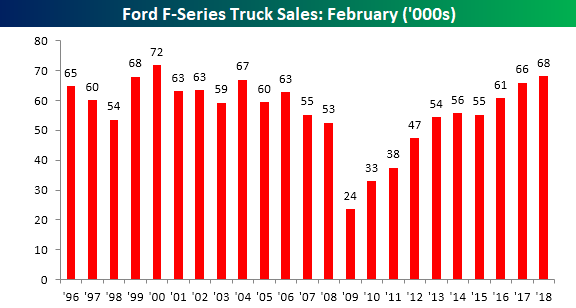
- Powell testimony spooked the market, which saw indications of a more hawkish Fed. The market has consistently been less bullish on the economy than the Fed, expecting a slow pace of rate increases. Eddy Elfenbein notes that the futures market moved the chance of a fourth hike this year to 33.5%. He is skeptical. Prof. Tim Duy, our go-to expert on the Fed, focused more on the precise language, particularly the concern about an overheated economy.
My focus fell on this in the written testimony:
In gauging the appropriate path for monetary policy over the next few years, the FOMC will continue to strike a balance between avoiding an overheated economy and bringing PCE price inflation to 2 percent on a sustained basis.
This is a crucial sentence that marks a change in focus. Compare this with the previous version of this testimony, delivered by former Federal Reserve Chair Janet Yellen in July of last year:
The Committee continues to expect that the evolution of the economy will warrant gradual increases in the federal funds rate over time to achieve and maintain maximum employment and stable prices.
In a follow up post, Prof. Tim analyzes the increased concern with inflationary pressures.
[Jeff] The Fed has typically waited too long to hike rates and been unable to stop incipient inflation. Financial markets can handle a gradual increase in rates. Transparency about Fed intentions and criteria is helpful.
- The steel and aluminum tariff announcement was a surprise to most, including those in the Administration. The swift reaction showed that this is a market-unfriendly step, although it was a temporary positive for a handful of steel stocks.
The Ugly
Nuclear escalation. Putin announces new nukes, designed to avoid US defense systems. Some suggest that this is linked to recently-proposed US weapons modernization and expansion. Others see it as political posturing.
The Week Ahead
We would all like to know the direction of the market in advance. Good luck with that! Second best is planning what to look for and how to react.
The Calendar
We have a normal economic calendar with an emphasis on employment. (The survey week for the BLS reports ended only two weeks ago. Occasionally the calendar pushes this report to the second Friday of the month). ISM Services is also of some interest.
Like it or not, the Washington circus may well dominate the news – once again.
Briefing.com has a good U.S. economic calendar for the week (and many other good features which I monitor each day). Here are the main U.S. releases.

Next Week’s Theme
The economic calendar is normal but features the report markets find most interesting – the employment situation. That topic may be of great interest by week’s end, but only if there is clarification on the tariff proposals. I expect many to be asking:
Has the US launched a trade war?
To explore the key question, I will do my typical list of alternatives followed by my own analysis. But first, I want to emphasize an important distinction, the difference between policy analysis and politics.
I often emphasize that people should separate their investment decisions from their political viewpoints. Deciding to sell all your stocks because you do not like an election result is a costly investment mistake. It is important to understand current public policy whether you agree with it or not. President George W. Bush’s tax cuts, President Obama’s Affordable Care Act, and President Trump’s tax policy changes are all good examples. You should not judge policy based upon whether you agree with the decision. Those who objected to the distributive effects of GOP tax cuts could do so as citizens but should not have ignored the economic effects. Whether or not they liked Obamacare, astute investors joined me in buying health insurance stocks.
That is what it means to separate investing and politics. In the last year, this distinction has become more difficult to make. Merely mentioning the name of the President seems to bring an end to careful analysis. That is not effective. Making good investments does not mean you must ignore hot-button issues. Estimating the chances for increased gun control, for example, is a subject for objective analysis. If your analysis is accurate, you may find some stocks to buy or to sell. Your personal policy preference is irrelevant to your investment decision.
This type of analysis can help us with the trade war issue. Here are the things that might happen. As usual, someone is making an argument for each possibility.
- The tariff announcement was just the start. Get ready for all out war, which the President views as “good and easy to win.” (WSJ)
- Expect a withdrawal from NAFTA to be next.
- Even without action on NAFTA, this will have a chilling effect on the current negotiations.
- Expect affected countries to retaliate against the US. (Politico)
- The Administration may walk this back, at least partially, in the face of widespread discontent among key constituencies.
- A reason may be found to treat this as a warning – a negotiating ploy.
- A change of policy may be softened with some other kind of help for steel companies.
As usual, I’ll suggest my own interpretations in today’s Final Thought.
Quant Corner
We follow some regular featured sources and the best other quant news from the week.
Risk Analysis
I have a rule for my investment clients. Think first about your risk. Only then should you consider possible rewards. I monitor many quantitative reports and highlight the best methods in this weekly update.
The Indicator Snapshot

Short-term trading conditions improved slightly this week. This is a good illustration of why you need objective indicators to follow rather than merely your impressions about events. We continue to monitor the technical health measures on a daily basis.
The long-term fundamentals and outlook have been unchanged through the recent bout of volatility.
The Featured Sources:
Bob Dieli: Business cycle analysis via the “C Score.
RecessionAlert: Strong quantitative indicators for both economic and market analysis.
Brian Gilmartin: All things earnings, for the overall market as well as many individual companies.
Doug Short: Regular updating of an array of indicators. Great charts and analysis.
Georg Vrba: Business cycle indicator and market timing tools. None of Georg’s indicators signal recession. His business cycle index, which we use in the Indicator Snapshot, is no longer “on the peg” at 100, but does not indicate a recession.
Guests:
Ed Yardeni, whom I frequently cite, has accurately forecast and monitored the economic effects on stocks. Some dislike corporate earnings reports because of reporting “shenanigans.” Revenue, much more difficult for companies to engineer, tells a similar story.

Insight for Traders
Our discussion of trading ideas has moved to the weekly Stock Exchange post. The coverage is bigger and better than ever. We combine links to trading articles, topical themes, and ideas from our trading models. Each week we explore a topic of current interest, drawing upon trading experts. This week we asked, “Do you trade the 50-day moving average?” This is a timely topic since so many indexes are close to those levels and the method is so popular. We also described how our trading models reacted, and updated the ratings lists for Felix and Oscar, this week featuring the Russell 2000. Blue Harbinger has taken the lead role on this post, using information both from me and from the models. He is doing a great job, presenting a wealth of new ideas and information each week.
While my intent is to focus on traders, long-term investors may benefit from a better understanding of what the issues are for traders.
Insight for Investors
Investors should have a long-term horizon. They can often exploit trading volatility! I remind investors of this each week, but now is the time to pay attention.
Best of the Week
If I had to pick a single most important source for investors to read this week it would naturally be Warren Buffett’s annual letter. You should take the time to read the whole thing, but I want to highlight a key point:
Investing is an activity in which consumption today is foregone in an attempt to allow greater consumption at a later date. “Risk” is the possibility that this objective won’t be attained.
By that standard, purportedly “risk-free” long-term bonds in 2012 were a far riskier investment than a long-term investment in common stocks. At that time, even a 1% annual rate of inflation between 2012 and 2017 would have decreased the purchasing-power of the government bond that Protégé and I sold.
I want to quickly acknowledge that in any upcoming day, week or even year, stocks will be riskier – far riskier – than short-term U.S. bonds. As an investor’s investment horizon lengthens, however, a diversified portfolio of U.S. equities becomes progressively less risky than bonds, assuming that the stocks are purchased at a sensible multiple of earnings relative to then-prevailing interest rates.
It is a terrible mistake for investors with long-term horizons – among them, pension funds, college endowments and savings-minded individuals – to measure their investment “risk” by their portfolio’s ratio of bonds to stocks. Often, high-grade bonds in an investment portfolio increase its risk.
Stock Ideas
Housing stocks have room to run (Lawrence C. Strauss, Barron’s).
Given strong demand, insufficient inventory, and modest annual price gains, many industry experts see the recovery continuing for several years—unless mortgage rates unexpectedly spike, spoiling what has been a tame but enjoyable party.
“You have a lot of buyers chasing very few houses,” says John Kendig, a long-time associate broker in the Richmond, Va., area. He says his clients recently missed out on an 1,800-square-foot brick colonial near the city even though the couple offered about $25,000 over the list price of $425,000.
“Housing is in the third or fourth inning of a nine-inning game,” says Bill Smead, lead portfolio manager of the $1.3 billion Smead Value fund, which holds shares of two home builders, Lennar (ticker: NYSE:LEN) and NVR (NVR), in a 28-stock portfolio. “This is a normally cyclical business in a secular growth trend.”
[Jeff] These are exactly the factors I have been citing for more than a year. Many housing reporters complain if prices are too high (unaffordable) or too low (bad market). They complain if there is too much inventory or too little. If interest rates go too low, potential buyers are just waiting. If they move higher, the buyers are suddenly priced out. I continue to like the sector.
My colleague at Seeking Alpha, Eric Basmajian, disagrees. Look at his analysis to see the other side.
Chuck Carnevale has sold Walmart (NYSE:WMT). In his comprehensive and careful analysis, he explains why. He also includes a video lesson. His post sparked a lot of dissent. Our colleague Jae Jun offers his own conclusion – a strong hold.
David Fish has an update on dividend champions for March. He tabulates recent statistics, notes the important changes, and takes a deeper look at Prudential (LON:PRU).
Hale Stewart smiles on Home Depot (NYSE:HD).
Blue Harbinger analyzes recent selling in the REIT market and identifies some attractive ideas.
Morningstar likes Motorola Solutions (NYSE:MSI). William Fitzsimmons sees a profitable niche and an economic moat.
Personal Finance
Seeking Alpha Senior Editor Gil Weinreich continues his excellent series. While theoretically aimed at advisors, there are many themes of interest for individual investors, especially this week! I especially enjoyed his advice on sources to follow. They are all good choices as Gil continues to build his list. I was delighted to be part of the first group he selected and welcome the new members (whom I have already been following and citing). Check out the post for descriptions of their background and some good example articles.
Abnormal Returns has a special Wednesday focus for individual investors. There are a variety of ideas, and nearly always something you will find useful. I especially liked David Merkel’s admonition about monitoring your financial accounts regularly. My runner-up was Ron Lieber’s (long) list of financial documents you should keep. This is great advice and will help me in conversations with Mrs. OldProf who thinks I should be more ruthless in discarding things.
Strategy
Stock pickers are doing better. (WSJ).
Might active management be more important in a down market? Morningstar has some evidence.
